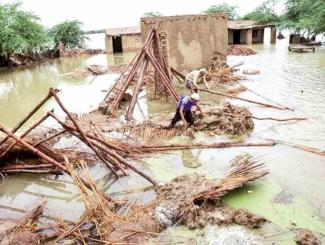More than thirty three million people were displaced in less than a month in Pakistan after the devastating monsoon floods hit the country. Pakistan experienced unusual rains in July and early August leading to inundation of one third of the country. The rainwater was accompanied by glacial melting and a flawed drainage system.
The intervention in Pakistan’s waters began in the 19th century when the French and British engineers set out to take control of the unruly waters and people of British India. The world's largest canal irrigation system was built using the justification that it would irrigate “wasteland” and bring an end to famine. In reality, the canal colonisation was a means to increase revenue and to find an avenue for capital investment of London financiers. The region continued to face famine despite the canal colonies; the canals were mostly supplying water to already irrigated areas leading to excess water supply. Crops such as wheat were replaced with water intensive crops such as rice and sugar leading to increased revenues for the British imperialists. The canals in various places have led to increased salinity and waterlogging, decreasing fertility of the soil.
The engineering of the Indus Basin continued post-Partition as India and Pakistan fought bitterly over their waters. As a result the World Bank stepped in as a negotiator, and brokered a technical solution, the Indus Water Treaty of 1960. According to this treaty, the water was now to be divided between India and Pakistan, the western rivers allotted to Pakistan and the eastern to India. The World Bank experts decided that large infrastructural dams would solve the issues of Pakistan’s hydraulic losses and provided funding for the Tarbela and Mangla Dams. As a result of these constructions, the water started depleting in the Indus Delta resulting in the migration of thousands of indigenous people. Pakistan is currently amongst the top 10 World Bank borrowers in the water sector.
Later, the World Bank continued interfering, with construction based on faulty plans, such as the Left Bank Outfall Drainage (LBOD) affecting the districts of Mirpur Khas, Sanghar and Badin. The design of LBOD was against the natural flow of the river Indus. Historically, the Indus effluent would fall in the Shakoor Lake before flowing to the sea. 80% of the Shakoor Lake is in India while 20% is in Pakistan. The experts again decided that instead of a political agreement, a technical solution should be sought. This time the technical solution was to dig forty miles into the sea to create an artificial canal, and build channels and weirs to direct water towards LBOD. The plan failed terribly, as the direction of the river was changed and it was against the tidal winds. The district of Badin was flooded in 2010 due to this LBOD leading to mass migrations and displacements. The LBOD this year again contributed to flooding in the same areas.
The story of Pakistan’s waters is one of colonial interventions, debt-fueled development models and no respect for the geography of the river. Pakistan as a result has multiple hazardscapes in the Indus Valley region, with flood water finding no way to reach the Arabian Sea. The once flourishing Indus delta is barren and has shrunk by more than 90% due to colonial and imperialist interventions.
Pakistan’s external debt is at $99 billion dollars, and even when the floods hit, most of the mainstream media was preoccupied by the approval of another loan by the IMF. It was not until 26th August that finally Pakistan’s politicians and media could turn their attention to the devastation of the floods. While the international media continued confronting Pakistani activists about the inept government, it conveniently forgot to discuss the role of colonialism, imperialism and debt-dependency all created by the global North. This is not to absolve the Pakistani state of its responsibility towards its people, but to learn about our collective pasts that have been engineered by the rich countries.
Today millions of Pakistan’s working class and peasantry suffer irreparable losses while the world at large escapes responsibility for the global climate crisis as well as historical legacies of colonial interventions. Today when we speak of debt-cancellation and colonial reparations, the global nexus of capitalists tries to shift the blame to our politicians, who as inept as they might be, are also not completely responsible for the devastation.
Today we know that South Asia is one of the regions worst affected by the climate crisis, which is no longer an apprehension about the future. It is already upon us. The crisis calls for a regional and internationalist politics rooted in anti-imperialism and decolonising our approaches to water, and against debt-dependent development . It is up to us to collectively come together to fight the battle forced upon us.
Tooba Syed is a Pakistani socialist feminist and gender researcher. She is associated with the left wing political party, Awami Workers Party and the feminist organisation Women Democratic Front which has been engaged in flood relief efforts since the devastating monsoon floods.









